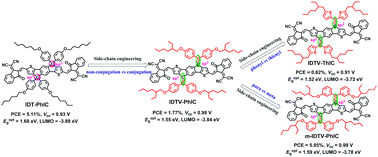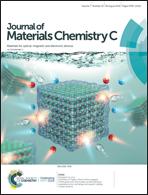Conjugated side-chain optimization of indacenodithiophene-based nonfullerene acceptors for efficient polymer solar cells†
Abstract
Taking account of the fascinating properties of photovoltaic materials with conjugated side chains and the great influence of side-chain engineering on molecular structures and optoelectronic properties, we herein successfully developed three novel A–D–A (A = acceptor unit, D = donor unit) type small molecular acceptors (SMAs), IDTV-PhIC, m-IDTV-PhIC, and IDTV-ThIC, based on a methylene-modified indacenodithiophene (IDT) donor building block (IDTV), in which four flanking aryls were introduced as the conjugated side chains by grafting onto the two ethylene bridges of the IDT unit. The effects of the conjugated side chain and its type (phenyl vs. thienyl) as well as the substitution position (para vs. meta) on the molecular structures, physicochemical properties, charge transport properties, film morphology and photovoltaic performance of these SMAs have been investigated systematically. Compared to the control molecule IDT-PhIC based on IDT, the three IDTV-based acceptors exhibit extended conjugation in the vertical direction, which can enlarge the π-electron delocalization region along the molecular backbone and thus broaden the absorption spectra, reduce the bandgaps and elevate energy levels. Additionally, the conjugated side chains far away from the framework of the IDTV segment can enhance the rigidity, resulting in decreased solubility and improved charge transport properties of the SMAs. Because of the synergistic effects of changing the conjugated side-chain type and substitution position, m-IDTV-PhIC with meta-hexyloxyphenyl as the conjugated side chains exhibits relatively good solubility, a broad absorption spectrum and a high-lying LUMO energy level, moderate molecular planarity and better charge transport properties and film morphology, which are beneficial for achieving higher Voc, Jsc, and FF in devices compared to the control IDT-PhIC and the other IDTV-based SMAs IDTV-PhIC and IDTV-ThIC. As a result, among these acceptors, a polymer solar cell (PSC) fabricated with m-IDTV-PhIC as an acceptor and polymer PBDB-T as the donor delivers the best PCE of 5.85% with both the highest Voc (0.99 V) and Jsc (11.58 mA cm−2). This work not only provides a simple and effective strategy for developing new A–D–A type SMAs with conjugated side chains but also proves that the side-chain modification is an effective approach to optimize photovoltaic performance of the acceptors in PSCs.



 Please wait while we load your content...
Please wait while we load your content...